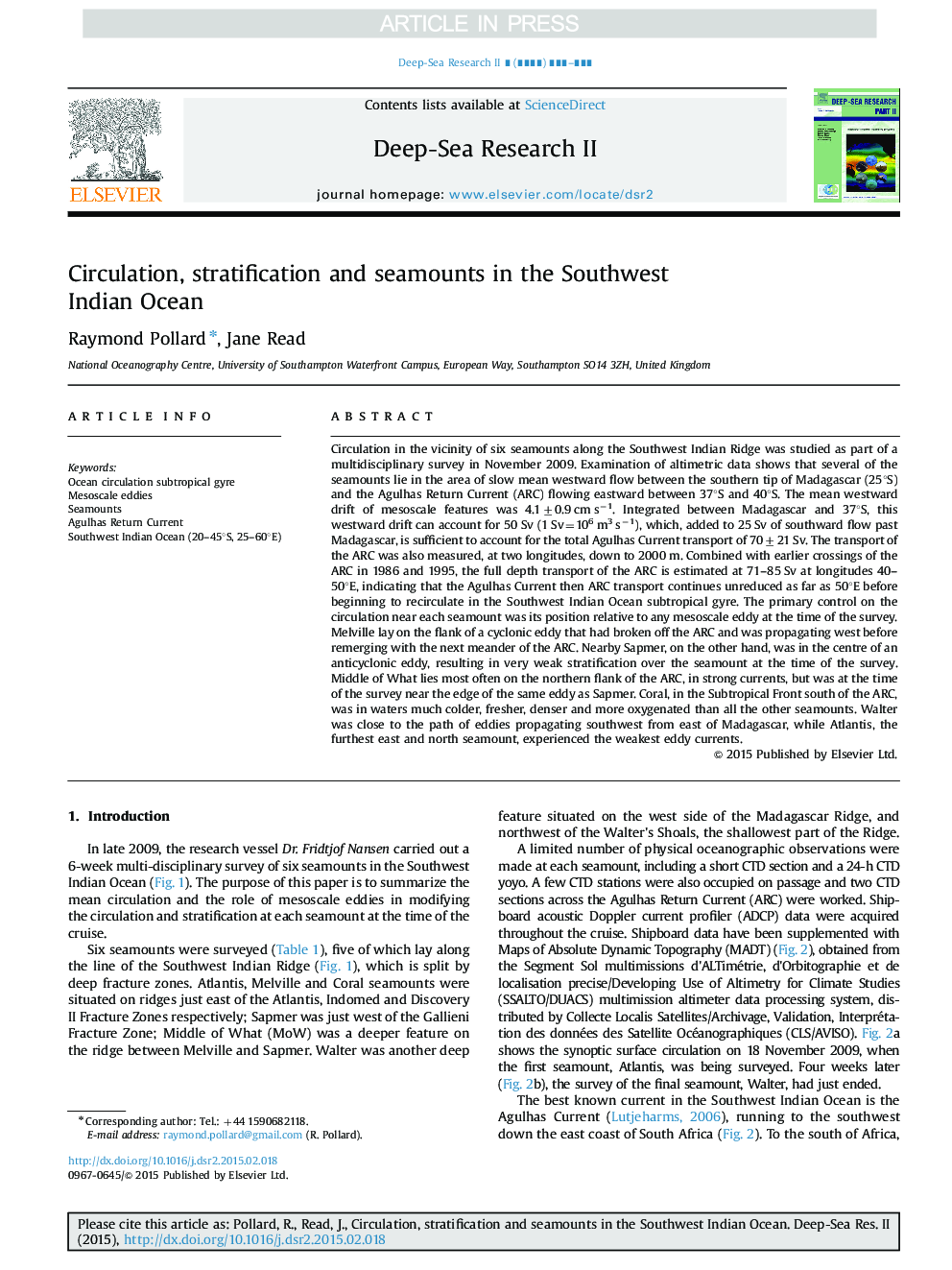| کد مقاله | کد نشریه | سال انتشار | مقاله انگلیسی | نسخه تمام متن |
|---|---|---|---|---|
| 5764858 | 1626406 | 2017 | 8 صفحه PDF | دانلود رایگان |
عنوان انگلیسی مقاله ISI
Circulation, stratification and seamounts in the Southwest Indian Ocean
ترجمه فارسی عنوان
گردش، طبقه بندی و ساحلی در جنوب غربی اقیانوس هند
دانلود مقاله + سفارش ترجمه
دانلود مقاله ISI انگلیسی
رایگان برای ایرانیان
کلمات کلیدی
موضوعات مرتبط
مهندسی و علوم پایه
علوم زمین و سیارات
زمین شناسی
چکیده انگلیسی
Circulation in the vicinity of six seamounts along the Southwest Indian Ridge was studied as part of a multidisciplinary survey in November 2009. Examination of altimetric data shows that several of the seamounts lie in the area of slow mean westward flow between the southern tip of Madagascar (25°S) and the Agulhas Return Current (ARC) flowing eastward between 37°S and 40°S. The mean westward drift of mesoscale features was 4.1±0.9 cm sâ1. Integrated between Madagascar and 37°S, this westward drift can account for 50 Sv (1 Sv=106 m3 sâ1), which, added to 25 Sv of southward flow past Madagascar, is sufficient to account for the total Agulhas Current transport of 70±21 Sv. The transport of the ARC was also measured, at two longitudes, down to 2000 m. Combined with earlier crossings of the ARC in 1986 and 1995, the full depth transport of the ARC is estimated at 71-85 Sv at longitudes 40-50°E, indicating that the Agulhas Current then ARC transport continues unreduced as far as 50°E before beginning to recirculate in the Southwest Indian Ocean subtropical gyre. The primary control on the circulation near each seamount was its position relative to any mesoscale eddy at the time of the survey. Melville lay on the flank of a cyclonic eddy that had broken off the ARC and was propagating west before remerging with the next meander of the ARC. Nearby Sapmer, on the other hand, was in the centre of an anticyclonic eddy, resulting in very weak stratification over the seamount at the time of the survey. Middle of What lies most often on the northern flank of the ARC, in strong currents, but was at the time of the survey near the edge of the same eddy as Sapmer. Coral, in the Subtropical Front south of the ARC, was in waters much colder, fresher, denser and more oxygenated than all the other seamounts. Walter was close to the path of eddies propagating southwest from east of Madagascar, while Atlantis, the furthest east and north seamount, experienced the weakest eddy currents.
ناشر
Database: Elsevier - ScienceDirect (ساینس دایرکت)
Journal: Deep Sea Research Part II: Topical Studies in Oceanography - Volume 136, February 2017, Pages 36-43
Journal: Deep Sea Research Part II: Topical Studies in Oceanography - Volume 136, February 2017, Pages 36-43
نویسندگان
Raymond Pollard, Jane Read,
